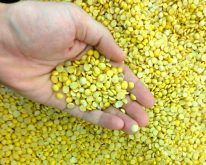MarketsFarm — There’s a possibility the government of India could lower its import duties on pulses, including those from Canada, according to reports.
With India’s monsoon rains having continued longer than usual, production of the country’s kharif (summer) pulse production fell by almost two million tonnes. Prior to the monsoons, market expectations called for 10.1 million tonnes, but those estimates were cut to 8.3 million because of excessive wet conditions, that included flooding. And this came only a year after India was said to be self-sufficient in pulses.
Read Also

U.S. grains: Wheat futures rise on supply snags in top-exporter Russia
U.S. wheat futures closed higher on Thursday on concerns over the limited availability of supplies for export in Russia, analysts said.
India’s National Agricultural Co-operative Marketing Federation (NAFED), which controls buffer stocks, might be able cover some or the entire shortfall, according to a report. Should there be a need for imports, NAFED would determine the volumes.
The Global Pulse Confederation (GPC) reported India’s domestic pulse consumption was estimated to be about 25.4 million tonnes and the country’s supply stood at 25.6 million tonnes. The GPC’s regional vice-president for South Asia, Anurag Tulsah, believes India might need to import 800,000 to one million tonnes of black gram and mung beans.
Associated with the extended monsoon rains were delays to planting the next round of crops. The GPC reported chana seeding was 25 per cent behind the 2018 pace, while in some parts of India, planting was much further behind with reports of up 92 per cent off of the pace. As for lentils, planting was 33 per cent behind.
Marcos Mosnaim of Globeway Canada in Mississauga cautioned that lower production in India won’t necessarily translate to the government reducing its import duties. Rather, the opposite could happen.
“On policy, it’s almost impossible to predict,” Mosnaim said of the Indian government.
Gordon Bacon, CEO of Pulse Canada, echoed that sentiment. “It is all speculation of what India might do,” he said.
India’s production can be driven by insufficient rain during the growing season or too much rain at critical periods, he said.
— Glen Hallick reports for MarketsFarm, a Glacier FarmMedia division specializing in grain and commodity market reporting. Includes files from Sean Pratt of the Western Producer.















